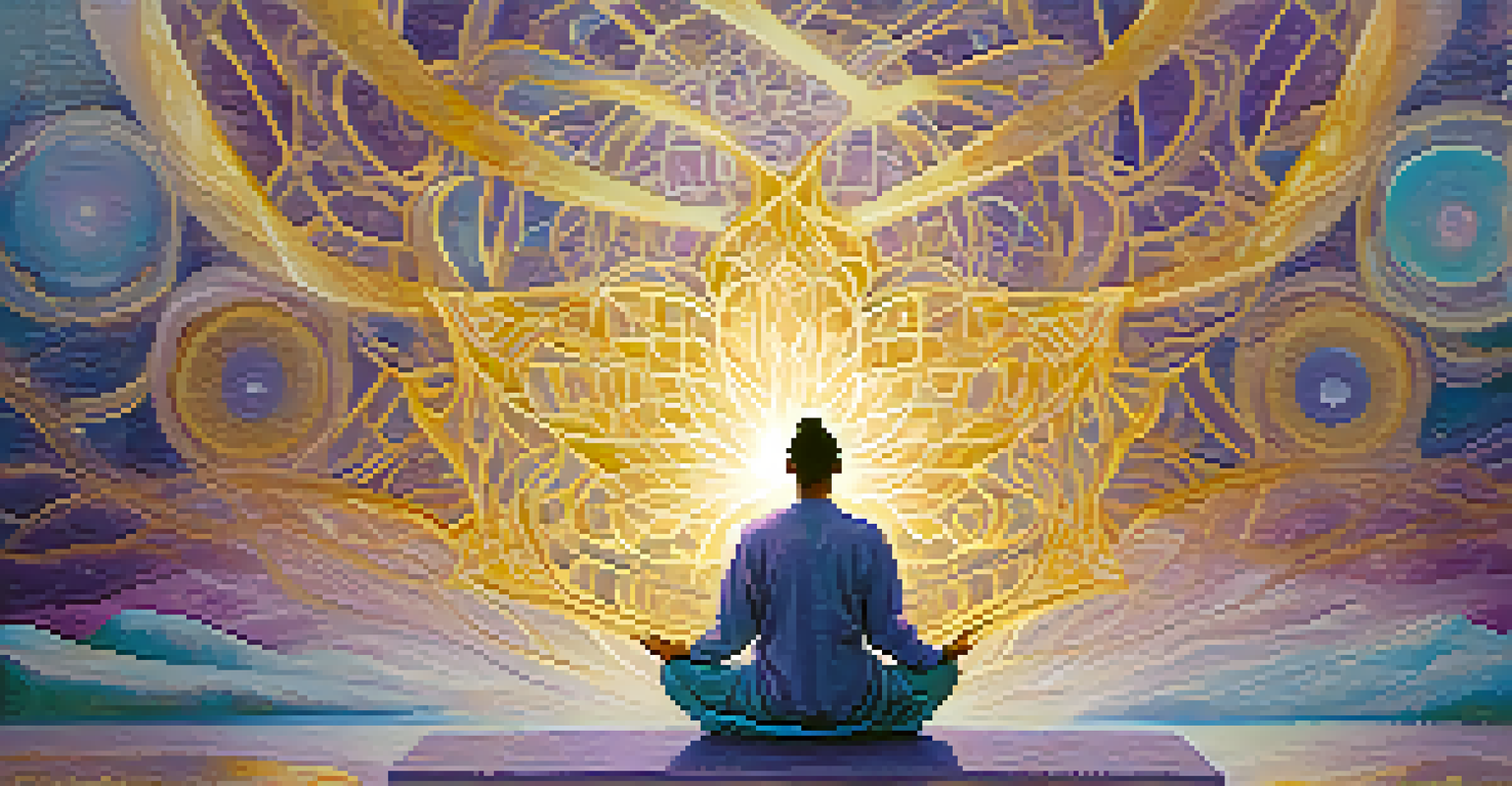Exploring the Neurochemical Impacts of Ayahuasca on the Brain

Understanding Ayahuasca and Its Components
Ayahuasca is a traditional Amazonian brew made from the Banisteriopsis caapi vine and the Psychotria viridis leaf. This potent combination contains the psychoactive compound DMT (dimethyltryptamine), known for its powerful effects on consciousness. When consumed, ayahuasca leads to profound experiences that many describe as spiritual or transformative.
The experience of ayahuasca is a profound exploration of the self, often leading to transformative insights about one's life and purpose.
The brew's unique blend not only promotes introspection but also interacts with neurotransmitter systems in the brain, particularly the serotonin system. Serotonin is often referred to as the 'feel-good' neurotransmitter, and its balance is crucial for regulating mood and emotions. Understanding how ayahuasca influences this system can shed light on its potential therapeutic benefits.
Additionally, the MAO inhibitors found in the Banisteriopsis caapi vine play a critical role, allowing DMT to remain active in the body longer than it would on its own. This synergy between the components of ayahuasca creates a unique neurochemical environment that facilitates intense psychological experiences.
The Role of DMT in Brain Function
DMT is often regarded as a 'molecule of the spirit' due to its powerful hallucinogenic properties. When ingested, it binds to serotonin receptors in the brain, particularly the 5-HT2A receptor, leading to altered perceptions and enhanced emotional experiences. This interaction can foster a deep connection to oneself and the surrounding environment, which many users describe as life-changing.

Research suggests that the effects of DMT can lead to significant changes in brain connectivity. Users often report experiencing a heightened sense of awareness, creativity, and emotional clarity. These effects are thought to arise from increased communication between different brain regions, promoting a more integrated and unified sense of self.
Ayahuasca's Complex Components
Ayahuasca is a potent brew combining DMT and MAO inhibitors, which together create profound psychoactive experiences.
Moreover, the release of DMT may mimic certain states of consciousness, such as dreaming or near-death experiences, which can provide insights into the nature of existence. This connection to deeper states of awareness may help individuals confront psychological challenges, offering a pathway for healing and personal growth.
Neurotransmitters and Emotional Regulation
Ayahuasca's impact on neurotransmitters goes beyond just DMT. The brew also influences the levels of serotonin, dopamine, and norepinephrine in the brain. These neurotransmitters play a significant role in regulating mood, motivation, and stress responses, making them vital to mental health.
Ayahuasca is a tool for self-discovery that can lead to healing, but it must be approached with respect and caution.
For example, increased serotonin levels can lead to enhanced mood and emotional resilience, while dopamine is associated with pleasure and reward. By modulating these chemical systems, ayahuasca may help individuals break free from negative thought patterns and emotional distress, promoting a more balanced state of mind.
Additionally, the experience of consuming ayahuasca often encourages users to confront and process unresolved emotional issues. This therapeutic aspect, coupled with the neurochemical changes, can create a powerful environment for emotional healing and personal insight.
The Therapeutic Potential of Ayahuasca
Given its profound effects on brain chemistry, ayahuasca is gaining attention as a potential treatment for various mental health conditions. Studies have shown promising results in using ayahuasca for depression, anxiety, and PTSD. The brew's ability to promote emotional catharsis and self-reflection may contribute to its therapeutic benefits.
Moreover, many users report long-lasting improvements in their mental health and well-being after participating in ayahuasca ceremonies. This suggests that the experiences facilitated by the brew may lead to lasting changes in thought patterns and emotional responses, providing a new avenue for healing.
Therapeutic Benefits Explored
Research indicates that ayahuasca may help treat mental health conditions like depression and PTSD through emotional healing.
However, it's essential to approach ayahuasca with caution, as individual experiences can vary widely. While some may find relief from their symptoms, others may face challenging emotional confrontations that require support and integration after the experience.
The Science Behind Ayahuasca Research
Research on ayahuasca is still in its infancy, but it's gradually gaining traction within the scientific community. Preliminary studies have begun to explore the neurochemical effects of ayahuasca and its potential applications in mental health treatment. These studies often focus on the brew's ability to alter brain function and improve emotional well-being.
For instance, brain imaging studies have shown that ayahuasca can increase connectivity in the default mode network, a brain network associated with self-referential thought and introspection. This finding supports the idea that ayahuasca facilitates deep self-exploration, which can be beneficial for psychological healing.
Despite the promising results, more rigorous research is needed to fully understand the long-term effects and potential risks associated with ayahuasca use. As interest in psychedelic research grows, ayahuasca may soon find its place as a valuable tool in mental health care.
Cultural Significance and Ritual Use
Ayahuasca has deep cultural roots, primarily among indigenous communities in the Amazon rainforest. For centuries, these cultures have used the brew in ceremonial contexts for healing, spiritual growth, and divination. The ritual aspect of ayahuasca is crucial, as it creates a safe space for participants to explore their consciousness and emotions.
During ceremonies, experienced guides or shamans lead participants through the experience, providing support and context for the journey. This communal aspect not only enhances the emotional safety of the experience but also fosters a sense of belonging and connection among participants.
Cultural Context Matters
Understanding the indigenous ceremonial use of ayahuasca is crucial for appreciating its potential benefits and respecting its traditions.
Understanding the cultural significance of ayahuasca is vital when considering its use in a modern context. It emphasizes the importance of respecting the traditions and practices of indigenous peoples while exploring the potential benefits of this powerful brew.
Potential Risks and Considerations
While ayahuasca offers many potential benefits, it is not without risks. The brew can produce intense psychological experiences that may be overwhelming for some individuals. It's crucial for potential users to be aware of their mental health history and any underlying conditions that could be exacerbated by such experiences.
Moreover, ayahuasca can interact with various medications, particularly those affecting serotonin levels, such as antidepressants. This can lead to dangerous side effects, including serotonin syndrome, which is a potentially life-threatening condition. Consulting with a healthcare professional before considering ayahuasca is essential for safety.

In conclusion, while ayahuasca holds promise for mental health treatment and personal growth, it is vital to approach its use with caution. Understanding both the potential benefits and risks can help individuals make informed decisions about their journey with this powerful brew.